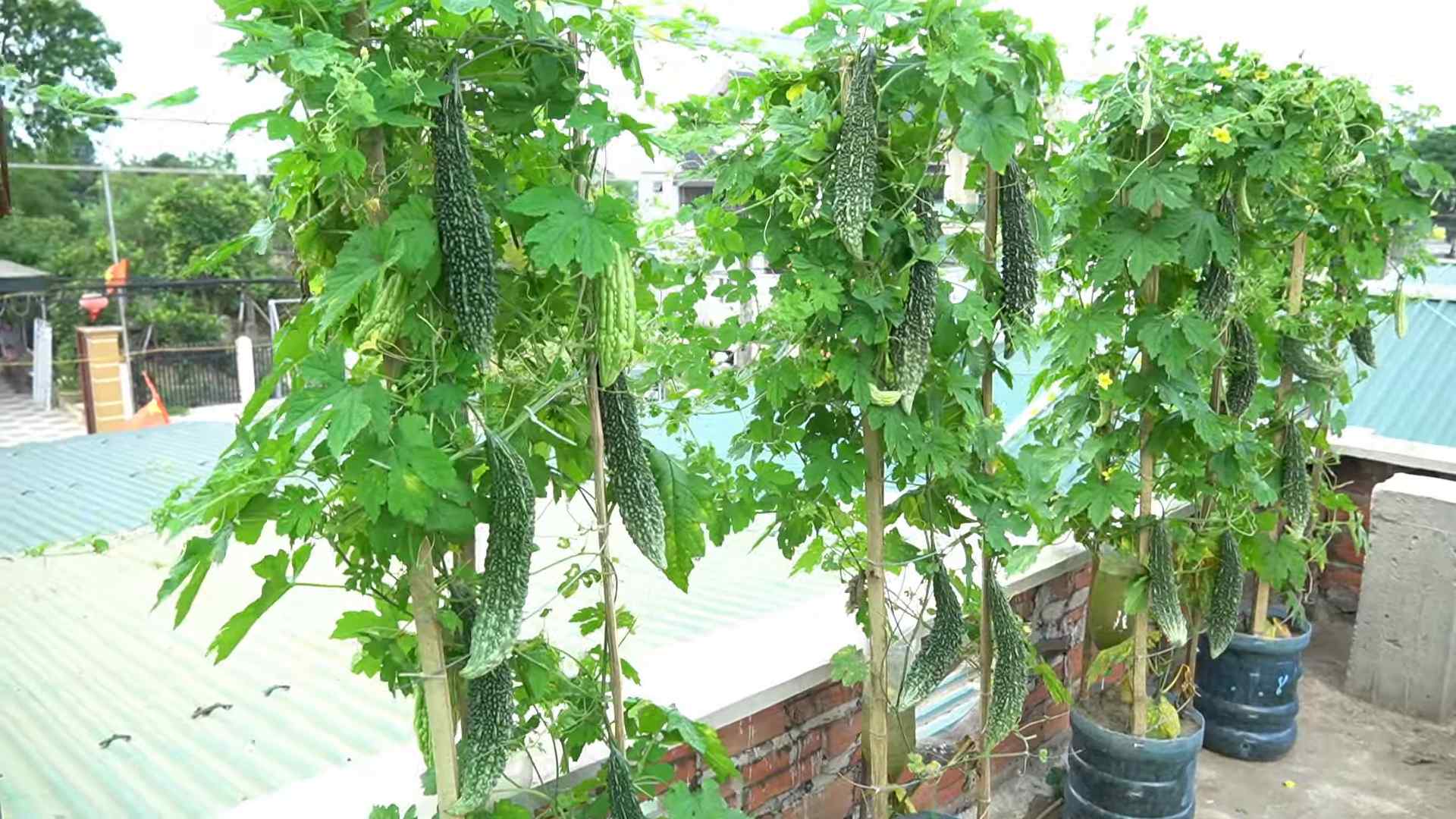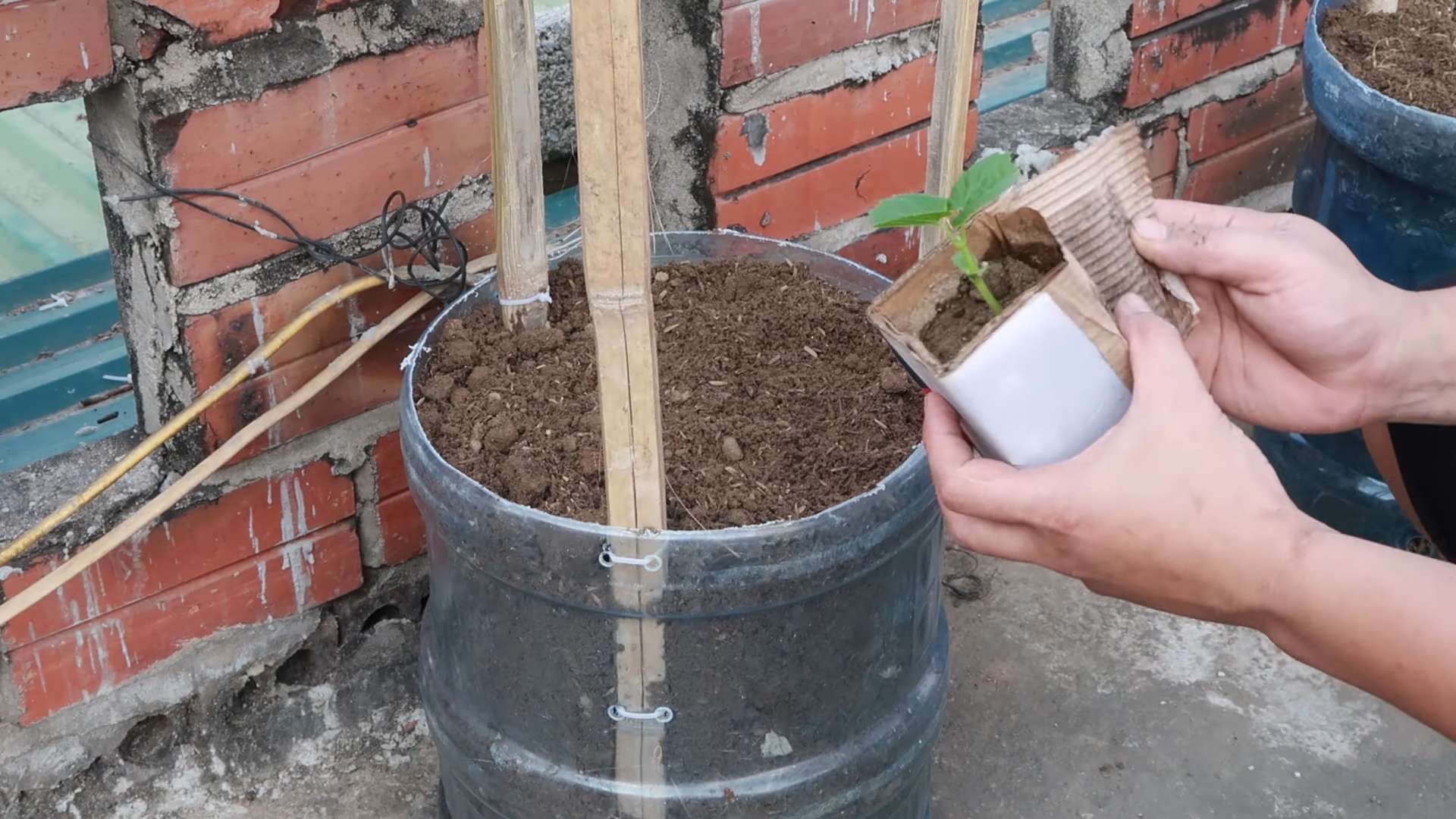Grow Bitter Melon at Home and unlock a world of culinary possibilities right in your backyard! Have you ever dreamed of harvesting your own exotic vegetables, bursting with flavor and packed with nutrients? Well, dream no more! This DIY guide is your passport to cultivating this unique and healthful gourd, even if you’re a complete beginner.
Bitter melon, also known as bitter gourd or karela, has a rich history deeply intertwined with traditional medicine and cuisine across Asia, Africa, and the Caribbean. For centuries, it’s been revered for its potential health benefits and distinctive, albeit acquired, taste. But you don’t need to travel the globe to enjoy its goodness.
Why should you embark on this home gardening adventure? Because growing your own bitter melon means access to fresher, more flavorful produce, free from harmful pesticides and herbicides. Plus, it’s incredibly rewarding to nurture a plant from seed to harvest! I’m going to show you some simple, effective tricks and hacks that will make grow bitter melon at home a breeze, even if you have limited space or experience. Say goodbye to expensive grocery store prices and hello to a thriving, homegrown harvest!

Growing Bitter Melon at Home: A Comprehensive DIY Guide
Hey there, fellow gardening enthusiasts! I’m so excited to share my experience with growing bitter melon, also known as bitter gourd or karela, right in my own backyard. It might seem intimidating at first, but trust me, with a little patience and these simple steps, you’ll be harvesting your own bitter melons in no time! This guide will walk you through everything, from seed starting to harvesting, ensuring you have a successful and rewarding experience.
Choosing the Right Variety and Preparing Your Seeds
Before we dive into the nitty-gritty, let’s talk about choosing the right bitter melon variety for your climate and preferences. There are several types available, differing in size, shape, and bitterness level. Some popular choices include:
* Chinese Bitter Melon: These are typically longer and lighter green, with a smoother skin and a milder bitter taste.
* Indian Bitter Melon: These are smaller, darker green, and have a more pronounced, bumpy texture. They also tend to be more bitter.
* Japanese Bitter Melon: These are usually medium-sized, with a slightly sweet taste compared to other varieties.
Once you’ve selected your variety, it’s time to prepare the seeds. Bitter melon seeds have a tough outer shell, so scarification and soaking can significantly improve germination rates.
Here’s how I prepare my bitter melon seeds:
1. Scarification: Gently rub the seeds with sandpaper or nick them with a knife. Be careful not to damage the inner part of the seed. This helps water penetrate the seed coat more easily.
2. Soaking: Soak the scarified seeds in warm water for 24-48 hours. This further softens the seed coat and encourages germination. Change the water every 12 hours to prevent bacterial growth.
3. Seed Starting Mix: While the seeds are soaking, prepare your seed starting mix. I like to use a mix of equal parts peat moss, perlite, and vermiculite. This provides good drainage and aeration.
Starting Your Bitter Melon Seeds Indoors
Starting your seeds indoors gives them a head start, especially if you live in a region with a shorter growing season. I usually start my seeds about 4-6 weeks before the last expected frost.
Here’s my step-by-step guide to starting bitter melon seeds indoors:
1. Fill Seed Trays or Pots: Fill your seed trays or small pots (2-3 inches in diameter) with the prepared seed starting mix.
2. Plant the Seeds: Make a small hole (about 1/2 inch deep) in the center of each pot or cell. Place one seed in each hole and cover it gently with the seed starting mix.
3. Water Gently: Water the soil gently using a spray bottle or watering can with a fine rose. Avoid overwatering, as this can lead to damping-off disease.
4. Provide Warmth and Light: Place the seed trays or pots in a warm location (around 75-85°F or 24-29°C). A heat mat can be helpful. Provide adequate light, either from a sunny windowsill or a grow light. If using a grow light, keep it a few inches above the seedlings.
5. Keep the Soil Moist: Keep the soil consistently moist, but not soggy. Check the moisture level daily and water as needed.
6. Transplant Seedlings: Once the seedlings have developed a few sets of true leaves (usually after 2-3 weeks), they’re ready to be transplanted into larger pots or directly into the garden (after hardening off).
Hardening Off Your Seedlings
Before transplanting your seedlings outdoors, it’s crucial to harden them off. This process gradually acclimates them to the outdoor environment, reducing the risk of shock.
Here’s how I harden off my bitter melon seedlings:
1. Day 1-3: Place the seedlings outdoors in a sheltered location (e.g., a shaded patio or porch) for 1-2 hours each day.
2. Day 4-6: Gradually increase the amount of time the seedlings spend outdoors each day, exposing them to more sunlight.
3. Day 7: Leave the seedlings outdoors for the entire day, but bring them back inside at night if temperatures are expected to drop below 50°F (10°C).
4. Day 8: If the weather is favorable, you can leave the seedlings outdoors overnight.
Preparing Your Garden Bed
Bitter melon thrives in warm weather and requires well-drained soil rich in organic matter. Choose a location that receives at least 6-8 hours of sunlight per day.
Here’s how I prepare my garden bed for bitter melon:
1. Soil Testing: Test your soil to determine its pH level and nutrient content. Bitter melon prefers a slightly acidic to neutral soil pH (6.0-7.0).
2. Soil Amendment: Amend the soil with plenty of compost, well-rotted manure, or other organic matter. This improves drainage, aeration, and fertility.
3. Fertilizing: Incorporate a slow-release fertilizer into the soil according to the package instructions. I like to use a balanced fertilizer with an NPK ratio of 10-10-10.
4. Trellis Installation: Bitter melon is a vine that needs a trellis or other support structure to climb. Install a sturdy trellis (at least 6-8 feet tall) before planting. You can use a wooden trellis, a metal fence, or even a sturdy tomato cage.
Transplanting Your Seedlings Outdoors
Once your seedlings are hardened off and your garden bed is prepared, it’s time to transplant them outdoors.
Here’s my step-by-step guide to transplanting bitter melon seedlings:
1. Choose a Cloudy Day: Transplant on a cloudy day or in the late afternoon to minimize stress on the seedlings.
2. Dig Holes: Dig holes that are slightly larger than the root balls of the seedlings. Space the holes about 2-3 feet apart.
3. Remove Seedlings from Pots: Gently remove the seedlings from their pots, being careful not to damage the roots.
4. Plant Seedlings: Place the seedlings in the holes and backfill with soil. Gently firm the soil around the base of the plants.
5. Water Thoroughly: Water the seedlings thoroughly after transplanting.
6. Mulch: Apply a layer of mulch around the base of the plants to help retain moisture, suppress weeds, and regulate soil temperature. I like to use straw or wood chips.
Caring for Your Bitter Melon Plants
Once your bitter melon plants are established, they require regular care to thrive.
Here are some essential tips for caring for your bitter melon plants:
* Watering: Water regularly, especially during dry periods. Keep the soil consistently moist, but avoid overwatering.
* Fertilizing: Fertilize every 2-3 weeks with a balanced liquid fertilizer.
* Pruning: Prune the vines to encourage branching and fruit production. Remove any yellowing or dead leaves.
* Pest and Disease Control: Monitor your plants regularly for pests and diseases. Common pests include aphids, spider mites, and squash bugs. Common diseases include powdery mildew and downy mildew. Treat any infestations or infections promptly with appropriate organic or chemical controls.
* Training the Vines: Train the vines to climb the trellis or support structure. Tie the vines to the trellis with soft twine or plant ties.
Pollination
Bitter melon plants produce separate male and female flowers. The female flowers have a small, immature fruit at the base, while the male flowers do not. Pollination is necessary for fruit development. If you notice that your plants are producing flowers but not fruit, you may need to hand-pollinate them.
Here’s how I hand-pollinate my bitter melon flowers:
1. Identify Male and Female Flowers: Identify the male and female flowers.
2. Collect Pollen: Use a small paintbrush or cotton swab to collect pollen from the male flowers.
3. Transfer Pollen: Gently transfer the pollen to the stigma of the female flowers.
4. Repeat: Repeat this process every day until the female flowers are pollinated.
Harvesting Your Bitter Melons
Bitter melons are typically ready to harvest about 2-3 months after planting. The exact timing depends on the variety and growing conditions.
Here’s how I harvest my bitter melons:
1. Check for Maturity: Look for fruits that are firm, have reached the desired size and color for your chosen variety, and are slightly tender to the touch.
2. Use Pruning Shears: Use sharp pruning shears or a knife to cut the fruit from the vine, leaving a short stem attached.
3. Harvest Regularly: Harvest regularly to encourage continued fruit production. Overripe fruits will become tough

Conclusion
So, there you have it! Growing bitter melon at home might seem daunting at first, but with a little patience, the right conditions, and this straightforward guide, you’ll be harvesting your own supply of this nutritious and unique vegetable in no time. The benefits of cultivating your own bitter melon extend far beyond simply having fresh produce at your fingertips. You gain complete control over the growing process, ensuring that your bitter melon is free from harmful pesticides and chemicals. Plus, there’s an undeniable satisfaction that comes from nurturing a plant from seed to harvest.
This DIY approach to growing bitter melon is a must-try for several reasons. Firstly, store-bought bitter melon can often be expensive and may not always be readily available, depending on your location. Secondly, the flavor of homegrown bitter melon is often superior, boasting a freshness and intensity that you simply can’t replicate with commercially grown varieties. Finally, and perhaps most importantly, growing your own food is an empowering experience that connects you to the natural world and promotes a more sustainable lifestyle.
Don’t be afraid to experiment with different varieties of bitter melon to find your favorite. Some popular choices include the Chinese bitter melon, which is typically longer and smoother, and the Indian bitter melon, which is smaller and more heavily ridged. You can also try growing your bitter melon on different types of trellises or supports to see what works best in your garden. Consider companion planting with herbs like basil or marigolds, which can help deter pests and attract beneficial insects.
We encourage you to embrace the challenge and embark on your own bitter melon growing adventure. The rewards are well worth the effort. Imagine the delicious and healthy meals you can create with your homegrown bitter melon – from stir-fries and soups to refreshing juices and teas.
But the journey doesn’t end here! We want to hear about your experiences. Did you find this guide helpful? What challenges did you encounter, and how did you overcome them? What are your favorite ways to prepare and enjoy bitter melon? Share your tips, tricks, and photos in the comments below. Let’s build a community of passionate home gardeners and celebrate the joys of growing our own food, one bitter melon at a time. Remember, mastering the art of how to grow bitter melon is an investment in your health, your well-being, and your connection to the earth. So, get planting!
Frequently Asked Questions (FAQ)
Q: How long does it take to grow bitter melon from seed to harvest?
A: Generally, it takes about 60 to 80 days from planting the seeds to harvesting your first bitter melon. However, this can vary depending on the specific variety of bitter melon, the growing conditions, and the climate. Warmer temperatures and consistent moisture will promote faster growth. Starting seeds indoors a few weeks before the last expected frost can also give you a head start.
Q: What are the best growing conditions for bitter melon?
A: Bitter melon thrives in warm, sunny locations with well-drained soil. It requires at least 6-8 hours of direct sunlight per day. The ideal soil pH is between 6.0 and 6.8. Ensure the soil is rich in organic matter by amending it with compost or well-rotted manure before planting. Consistent watering is crucial, especially during hot and dry periods. Providing a trellis or other support structure is essential, as bitter melon vines can grow quite long.
Q: How often should I water my bitter melon plants?
A: Water your bitter melon plants deeply and regularly, especially during hot weather. Aim to keep the soil consistently moist but not waterlogged. A good rule of thumb is to water when the top inch of soil feels dry to the touch. Mulching around the base of the plants can help retain moisture and suppress weeds. During periods of heavy rainfall, you may need to reduce watering to prevent root rot.
Q: What are some common pests and diseases that affect bitter melon?
A: Common pests that can affect bitter melon include aphids, spider mites, and squash bugs. Regularly inspect your plants for signs of infestation and take appropriate action, such as using insecticidal soap or neem oil. Diseases that can affect bitter melon include powdery mildew and downy mildew. Ensure good air circulation around the plants and avoid overhead watering to minimize the risk of these diseases. Fungicides can be used if necessary, but always follow the instructions on the label.
Q: How do I know when my bitter melon is ready to harvest?
A: Bitter melon is typically harvested when it is still green and slightly immature. The fruit should be firm to the touch and have a slightly waxy appearance. Overripe bitter melon will turn yellow or orange and become more bitter. The exact size and color at harvest will depend on the specific variety. It’s best to harvest in the morning when the fruit is cool. Use a sharp knife or pruning shears to cut the fruit from the vine, leaving a short stem attached.
Q: Can I grow bitter melon in a container?
A: Yes, you can successfully grow bitter melon in a container, provided you choose a large enough pot (at least 10-15 gallons) and provide adequate support for the vines. Use a well-draining potting mix and ensure the container has drainage holes. Container-grown bitter melon may require more frequent watering and fertilization than plants grown in the ground. Place the container in a sunny location and provide a trellis or other support structure for the vines to climb.
Q: How can I reduce the bitterness of bitter melon?
A: Bitter melon is known for its distinctive bitter taste, but there are several ways to reduce its bitterness. One common method is to soak the sliced bitter melon in salted water for about 30 minutes before cooking. This helps to draw out some of the bitter compounds. You can also blanch the bitter melon in boiling water for a few minutes before using it in your recipes. Another technique is to remove the white pith and seeds from the center of the melon, as these are the most bitter parts. Cooking bitter melon with acidic ingredients like vinegar or lemon juice can also help to balance the bitterness.
Q: Can I save seeds from my bitter melon to plant next year?
A: Yes, you can save seeds from your bitter melon to plant next year. Allow the fruit to fully ripen on the vine until it turns yellow or orange. Then, harvest the fruit and scoop out the seeds. Wash the seeds thoroughly and spread them out on a paper towel to dry completely. Store the dried seeds in an airtight container in a cool, dark, and dry place. Properly stored bitter melon seeds can remain viable for several years.
Q: What are some creative ways to use bitter melon in cooking?
A: Bitter melon is a versatile ingredient that can be used in a variety of dishes. It is commonly used in stir-fries, soups, and stews. You can also juice bitter melon or make it into a tea. Some popular recipes include bitter melon with eggs, bitter melon stuffed with meat, and bitter melon curry. Experiment with different flavors and spices to find your favorite ways to enjoy this unique vegetable. Don’t be afraid to try new things and get creative in the kitchen!
Q: Is bitter melon good for my health?
A: Yes, bitter melon is packed with nutrients and has been linked to various health benefits. It is a good source of vitamins A and C, as well as iron and potassium. Some studies suggest that bitter melon may help regulate blood sugar levels, making it a potentially beneficial food for people with diabetes. It also contains antioxidants that can help protect against cell damage. However, it’s important to note that more research is needed to fully understand the health benefits of bitter melon. Always consult with a healthcare professional before making any significant changes to your diet.





Leave a Comment